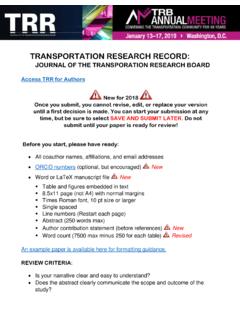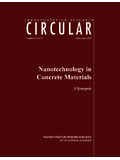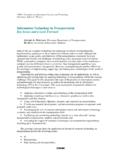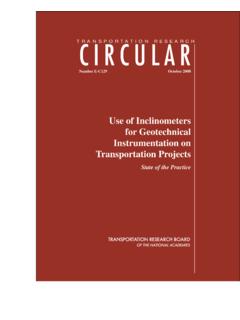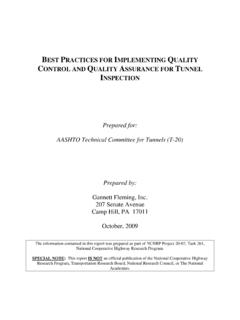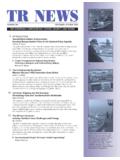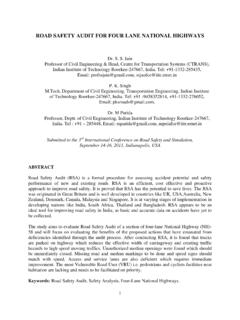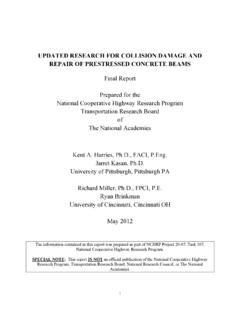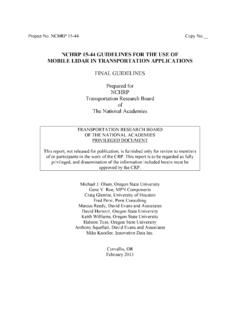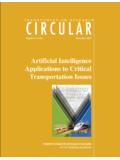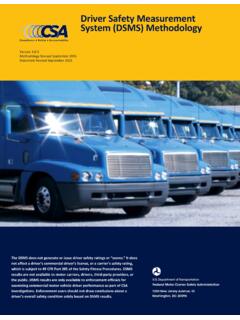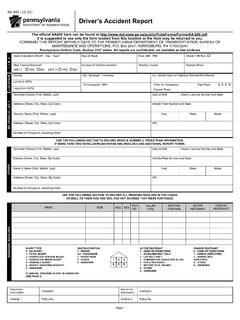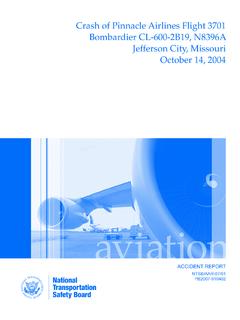Transcription of METHODOLOGY TO INTRODUCE SCENARIOS OF ACCIDENT …
1 1 METHODOLOGY TO INTRODUCE SCENARIOS OF ACCIDENT IN DRIVING SIMULATORS INTEREST FOR THE ANALYSIS OF DRIVERS BEHAVIOR Catherine Berthelon Senior Researcher, IFSTTAR (French institute of science and technology for transport, development and networks), Research unit of Accidents Mechanism analysis (MA), Salon de Provence, France, e-mail: Isabelle Aillerie Ingenior, IFSTTAR (French institute of science and technology for transport, development and networks), Research unit LEPSIS, Salon de Provence, France, e-mail: Christophe Perrin Researcher, IFSTTAR (French institute of science and technology for transport, development and networks), Research unit of Accidents Mechanism analysis (MA), Salon de Provence, France, e-mail: St phane Espi Senior Researcher, IFSTTAR (French institute of science and technology for transport, development and networks), Infrastructure and Mobility Department (IM), Paris, France, e-mail: Submitted to the 3rd International Conference on Road Safety and Simulation, September 14-16, 2011, Indianapolis, USA ABSTRACT Simulators provide a fairly realistic reproduction of driving environments so that the behavior of drivers immersed in such systems is representative of what can be expected on the road.
2 However, situations and SCENARIOS which are introduced in these simulators are sometimes too approximately defined and not very realistic. We have thus developed a METHODOLOGY to simulate ACCIDENT SCENARIOS . The scenario concept used concerns a group of accidents presenting similarities from the point of view of the chain of events leading to the collision. The sequential analysis method used to group accidents in the form of SCENARIOS is based on a segmentation of their progression. A set of SCENARIOS have been spatio-temporally implemented into the IFSTTAR1 simulator using data from real accidents collected in the French in-depth accidents investigations program EDA from the research unit, 1 The two institutes, LCPC (Central laboratory of roads and bridges) and INRETS (National institute for transport and safety research), merged on the 1st of January 2011 to create IFSTTAR (French institute of science and technology for transport, development and networks).
3 2 ACCIDENT Mechanism analysis. They have then been validated before being submitted to different populations of drivers. Methodological aspects of this procedure are described and past use of such SCENARIOS is evoked: for example to study drivers capacities as a function of driving experience, or the effects of alcohol and medicines. Finally, some examples are given concerning future development, ACCIDENT SCENARIOS to be introduced in a powered two-wheeled simulator. Keywords: METHODOLOGY , driving simulation, ACCIDENT SCENARIOS , in-depth ACCIDENT investigation . INTRODUCTION Simulators became indispensable tools for improving our understanding in the field of automobile driving. Investigations carried out with this type of tool concern driver behavior, vehicle design, road infrastructure design and training.
4 Simulators provide many advantages: absence of risk, reproducibility of situations, control of experimental parameters, time saved and reduced costs. Their flexibility also makes it possible to test situations that do not exist in reality or that only rarely and randomly occur. It is indeed the only safe way of exposing drivers to dangerous situations. Simulators are therefore indispensable, notably when studying ACCIDENT -causing situations. Note however that the absence of risk, which is often considered an advantage, also raises questions when studying objectively risky situations. Validation of the simulator s characteristics, in another hand, is vital before interpretation. The first level of simulator validity relies on the correspondence of the simulator s layout and dynamics with those of real vehicles and environment, referred to as physical validity , which supposes that the simulator s dynamics accurately model those of a car.
5 Moreover, their use entails verifying that the trends observed in a virtual setting are identical to those commonly observed on the road, their behavioral validity . Studies show that behavioral validity can be a relative . For example, when approaching a curve, drivers speed profiles, but not values, are similar on a simulator and on the road (Godley et al., 2002), drivers seem in fact to adopt slower speeds on a simulator than on the road (Klee et al., 1999). Also, the classification of intersection dangerousness obtained experimentally was congruent with the crash information for their field counterparts (Yan et al., 2008). The work presented here is part of the research and development field for SCENARIOS used on driving simulators.
6 Its purpose is to assess the relevance of including SCENARIOS identified as ACCIDENT -producers in simulation systems. The general hypothesis is that including them makes it possible to confront different populations of subject with difficult situations rarely encountered in natural driving conditions. First, we will present our work on prototypical ACCIDENT SCENARIOS and the method used by researchers at IFSTTAR to identify them. We will then present the way in which these SCENARIOS are implemented using objective data from the detailed data gathered on accidents before including them on the driving simulators. Lastly, we will talk about the different studies already carried out with such SCENARIOS and current projects using this method. 3 METHODOLOGY ACCIDENT SCENARIOS The concept of scenario, in the widest sense of the term, refers to the implementation of situations in which events occur in order to provoke a behavior (Fischer et al.)
7 , 2002). In the literature relative to road safety, this concept refers to a category or type of ACCIDENT . SCENARIOS reproduce infrastructures and prototypical situations that generate accidents. They correspond to a group of accidents presenting overall similarities from the point of view of the chain of events and causal relationships in the different phases leading up to the collision, and are actually prototypes of ACCIDENT processes. The term prototype is used in reference to cognitive psychology to emphasize the fact that ACCIDENT SCENARIOS are abstract constructions that demonstrate the main traits of a set of accidents presenting similarities, and not a particular, concrete ACCIDENT process behind any one of them. In general, the accidents in this set do not have an identical prototypical process, but are more or less similar (Fleury and Brenac, 2001; Brenac et al.
8 , 2003). The procedure for drawing up prototypical SCENARIOS has been largely described by their initiators and we will only go over the principal features (Fleury and Brenac, 2001). Representative samples of bodily-injury accidents for which procedures have been gathered by the police are used to draw up these SCENARIOS . These procedures are rounded out, insofar as possible, by a collection of maps and photographs of the ACCIDENT sites (Clabaux and Brenac, 2010). The ACCIDENT is then considered as a series of phases or sequences that are linked chronologically and causally2. This breakdown takes into account the spatio-temporal evolution of the situation as well as the interactions between the different parties involved.
9 Its application to ACCIDENT procedures established by the police makes it possible to extract prototypical ACCIDENT SCENARIOS and to determine all the factors playing a role in accidents (Brenac, 1997). The researchers at the IFSTTAR ACCIDENT Mechanism analysis research unit have therefore listed a certain number of ACCIDENT SCENARIOS (Brenac et al., 2003), (Brenac & Fleury, 1999), (Brenac et al., 1996). Based on this work, a selection of prototypical SCENARIOS can be made. In order to implement them spatio-temporally with precision, real ACCIDENT data have to be associated with them. These data are available in the IFSTTAR in-depth accidents study database. In-depth accidents investigations (EDA in French) The objective of the in-depth accidents investigations (EDA) carried out at IFSTTAR in Salon de Provence is to increase the understanding of ACCIDENT -causing mechanisms and dysfunctional processes in the road system.
10 Highly detailed data, gathered in part at ACCIDENT scenes, are used to reconstruct and describe their process, to explain the chain of causality behind this process, 2 The sequential ACCIDENT analysis method used to aggregate prototypical SCENARIOS is the result of in-depth accidents investigations. It was adapted to the study of police reports and the safety diagnosis context, which makes it possible to make a wider grouping of samples. 4 and to identify factors among the characteristics of the users, vehicles and infrastructures which, if controlled, could constitute preventive action. EDA are based on: - a system approach (interactions between users, travel tools and infrastructures), - an analysis model (breakdown into phases of the ACCIDENT process, described above), - a kinematic model (reconstruction and configuration of the ACCIDENT dynamic in time and space), - an operating model of the human operator (data processing system).
